A Mini Review on Borate Photocatalysts for Water Decomposition: Synthesis, Structure, and Further Challenges
Abstract
:1. Introduction
2. Fundamentals of Borate Photocatalytic Water Decomposition Reactions
2.1. The Mechanism of the Water Decomposition Reaction of Borate Photocatalysts
2.2. Several Concepts of Photocatalytic Water Decomposition Reactions
3. Synthetic Chemistry of Borate Photocatalysts
3.1. High-Temperature Solid-State Method
3.2. Complex Gelation Method or Sol-Gel Method
3.3. Precipitation Method
3.4. Hydrothermal Method
3.5. Boric-Acid Flux Method
3.6. High-Pressure Method
4. Structural Characterization of Borate Photocatalyst
| Photocatalyst | Crystal Structure | Crystal System | Spaces Group | B-O Unit | Comment | Bandgap /eV | Refs. |
|---|---|---|---|---|---|---|---|
| K3Ta3B2O12 | tungsten bronze | hexagonal | P-62m | BO3 isolated | Corner-sharing triads of TaO6 octahedra are stacked along the c-axis and are connected by planar BO3 groups. | 4.2 | [50] |
| Cd12Ge17B8O58 | - | tetragonal | P-4 | B2O7 isolated | The [Ge4O10.5]n polyhedra-chains along the c-axis were interconnected by [Ge(B2O7)4]28− clusters and the remaining vacancies were filled by Cd2+ to satisfy the charge neutrality. | 4.27 | [54,68] |
| PbGaBO4 | - | orthorhombic | Pnma | BO3 isolated | These GaO6 chains are interconnected by rigid BO3 triangles, leaving Pb2+ in an asymmetric coordination. | 4.10 | [56] |
| ZnGa-BLDH | - | hexagonal | - | B4O5(OH)42− | 2- It obtained the borate anions B4O5(OH)2 intercalated ZnGa-BLDH ultrathin 2D nanosheets by a one-step hydrothermal method. | 4.94 | [60] |
| InBO3 | calcite | trigonal | R-3cH | BO3 isolated | The InO6 octahedral units connect with each other by corner sharing, and link with the BO3 triangular units. | 5.4 | [62,63] |
| In5B12O25(OH) | - | tetragonal | I41/acd | B12O25(OH) | A set of twelve corner-sharing BO4 tetrahedra forms either a cuboctahedral cage or two six-membered curved strings that enlace the distorted In2O6 octahedra. | - | [66] |
| In19B34O74(OH)11 | trigonal | R-3 | B4O10 | The central structural motifs in In19B34O74(OH)11 are [B4O10]8− supertetrahedra located in the center of a -3 axis. | - | [64] | |
| Ga4B2O9 | mullite | monoclinic | C2/m | BO3 isolated BO4 isolated | The GaO6 octahedra share edges to form chains along the b-axis, and the chains are cross-linked by GaO5, BO3, and BO4 groups. | 4.12 | [53,69] |
| Ga2B3O7(OH) | - | orthorhombic | Cmce | B12O25(OH) | Similar to In5B12O25(OH). | 4.0 | [65] |
| Ga-PKU-1 | - | trigonal | R3 | BO2(OH) isolated B2O4(OH) isolated | Borate groups, in the form of BO2(OH) and B2O4(OH) fragments, attach to the GaO6 framework and neutralize the negative charges by sharing vertex oxygen atoms. | 4.8 | [61,70] |
| Cu-Borate-1 | - | tetragonal | I-4 | B4O7(OH)2 isolated | The {B20} cluster was built by four alternated [B4O7(OH)2] clusters and four BO3 triangles via common oxygen atoms. | 2.3 | [59] |
| Cu-Borate-2 | - | tetragonal | I-4 | B4O7(OH)2 isolated | The same as Cu-Borate-1. | 2.3 | [59] |
| CuB2O4 | - | tetragonal | I-42d | B3O6 network | The CuO4 is at the centre of the quadratic axis and it is surrounded by a mesh of eight BO4 tetrahedra. | 3.30 | [55] |
| Cu3B2O6 | - | triclinic | P-1 | BO4 isolated | The layers are linked to one another by BO4 tetrahedra. | 2.47 | [55] |
| Co3B2O6 | kotoite | orthorhombic | Pnmn | BO3 isolated | Each metal site is surrounded by an oxygen atom of planar borate groups to afford an octahedral environment. | - | [49] |
| Co2NiB2O6 | kotoite | orthorhombic | Pnmn | BO3 isolated | The same as Co3B2O6. | - | [49] |
| CoNi2B2O6 | kotoite | orthorhombic | Pnmn | BO3 isolated | The same as Co3B2O6. | - | [49] |
| Ni3B2O6 | kotoite | orthorhombic | Pnmn | BO3 isolated | The same as Co3B2O6. | - | [49] |
5. Borate Photocatalyst for Photocatalytic Decomposition of Water
5.1. Borate Photocatalyst for Overall Water Splitting
5.1.1. One-Dimensional Chain Borate Photocatalyst
K3Ta3B2O12
Cd12Ge17B8O58
5.1.2. Three-Dimensional Network Borate Photocatalyst
InBO3
Ga-PKU-1
Ga4B2O9
5.2. Borate Photocatalysts with Wide Bandgap (≥4.0 eV) for HEHR or OEHR
5.2.1. One-Dimensional Chain Borate Photocatalyst
5.2.2. Two-Dimensional Layer Borate Photocatalyst
5.2.3. Three-Dimensional Network Borate Photocatalyst
5.3. Borate Photocatalysts with Narrow Bandgap (≤3.3 eV) for HEHR or OEHR
6. Conclusions and Perspectives
- (1)
- Considering the B-O unit in the borate photocatalyst, the number of B atoms therein is, in principle, less than 6 is more appropriate; the exception is that the number of B atoms in the B-O unit in the borate photocatalyst obtained by the high-pressure method is 12.
- (2)
- From the cationic point of view in borate photocatalysts there are metal-oxygen polyhedra in chains, layers, or networks usually considered to be favorable for photogenerated electron and hole transfer. Therefore, it is also possible to screen borates as photocatalysts from this point of view.
- (3)
- To develop visible light responsive borate photocatalysts, containing the first transition metal borates such as Cu, Co, and Ni can be selected. The photocatalytic oxygen evolution of these first transition metal borates is superior to the photocatalytic hydrogen evolution.
- (4)
- The preparation of borate photocatalysts should in principle avoid high-pressure methods and traditional high-temperature solid-phase methods, even hydrothermal methods, and it is appropriate to choose other soft-chemical synthesis methods, such as sol-gel, precipitation, boric acid flux, and modified solid-state methods. The basic principle is to obtain samples with high specific surface area and low defects.
- (1)
- Water decomposition reactions have been an important part of photocatalytic research. The borates as an emerging group of water decomposition photocatalysts, and the conclusions summarised in this paper will contribute to the discovery of new borate photocatalysts.
- (2)
- The first transition metal borates summarised in this paper will help researchers to design new borate-containing composites for water splitting reactions with a visible light-responsive ability.
- (3)
- Improvement of the preparation methods or development of new preparation methods based on the existing synthesis methods of borate photocatalysts is expected.
- (4)
- Knoevenagel condensation of benzaldehyde with malononitrile in the presence of Ga4B2O9 catalyst produces phenylpropanedinitrile with 90% selectivity [70]. Ga4B2O9 efficiently catalyzes the dehydrogenation of n-propanol to obtain malonaldehyde with high selectivity (79%), while Ga-PKU-1 catalyzes the dehydration process to obtain propylene with 94% selectivity [72]. This is attributed to the unique structure of these two borates in generating strong Lewis acids. However, there is a lack of studies on organophotosynthesis with borates.
Author Contributions
Funding
Conflicts of Interest
References
- Wang, Q.; Domen, K. Particulate photocatalysts for light-driven water splitting: Mechanisms, challenges, and design strategies. Chem. Rev. 2020, 120, 919–985. [Google Scholar] [CrossRef] [PubMed]
- Tang, D.; Tan, G.-L.; Li, G.-W.; Liang, J.-G.; Ahmad, S.M.; Bahadur, A.; Humayun, M.; Ullah, H.; Khan, A.; Bououdina, M. State-of-the-art hydrogen generation techniques and storage methods: A critical review. J. Energy Storage 2023, 64, 107196. [Google Scholar] [CrossRef]
- Dawood, F.; Anda, M.; Shafiullah, G.M. Hydrogen production for energy: An overview. Int. J. Hydrogen Energy 2020, 45, 3847–3869. [Google Scholar] [CrossRef]
- Chi, J.; Yu, H. Water electrolysis based on renewable energy for hydrogen production. Chin. J. Catal. 2018, 39, 390–394. [Google Scholar] [CrossRef]
- Chen, S.; Takata, T.; Domen, K. Particulate photocatalysts for overall water splitting. Nat. Rev. Mater. 2017, 2, 17050. [Google Scholar] [CrossRef]
- Fujishima, A.; Kenichi, H. Electrochemical photolysis of water at a semiconductor electrode. Nature 1972, 238, 37–38. [Google Scholar] [CrossRef] [PubMed]
- Tryk, D.; Fujishima, A.; Honda, K. Recent topics in photoelectrochemistry: Achievements and future prospects. Electrochim. Acta 2000, 45, 2363–2376. [Google Scholar] [CrossRef]
- Rahman, M.Z.; Kibria, G.; Mullins, C.B. Metal-free photocatalysts for hydrogen evolution. Chem. Soc. Rev. 2020, 49, 1887–1931. [Google Scholar] [CrossRef] [PubMed]
- Zhang, G.; Lan, Z.; Wang, X. Conjugated polymers: Catalysts for photocatalytic hydrogen evolution. Angew. Chem. Int. Ed. 2016, 55, 15712–15727. [Google Scholar] [CrossRef]
- Wang, H.; Zhang, L.; Chen, Z.; Hu, J.; Li, S.; Wang, Z.; Liu, J.; Wang, X. Semiconductor heterojunction photocatalysts: Design, construction, and photocatalytic performances. Chem. Soc. Rev. 2014, 43, 5234–5244. [Google Scholar] [CrossRef]
- Yang, J.; Sun, X. Borate particulate photocatalysts for photocatalytic applications: A review. Int. J. Hydrogen Energy 2022, 47, 25608–25630. [Google Scholar] [CrossRef]
- Armaković, S.J.; Savanović, M.M.; Šiljegović, M.V.; Kisić, M.; Šćepanović, M.; Grujić-Brojčin, M.; Simić, N.; Gavanski, L.; Armaković, S. Self-Cleaning and charge transport properties of foils coated with acrylic paint containing TiO2 nanoparticles. Inorganics 2024, 12, 35. [Google Scholar] [CrossRef]
- Wang, J.; Wang, Z.; Dai, K.; Zhang, J. Review on inorganic–organic S-scheme photocatalysts. J. Mater. Sci. Technol. 2023, 165, 187–218. [Google Scholar] [CrossRef]
- Yang, H.; Dai, K.; Zhang, J.; Dawson, G. Inorganic-organic hybrid photocatalysts: Syntheses, mechanisms, and applications. Chin. J. Catal. 2022, 43, 2111–2140. [Google Scholar] [CrossRef]
- Ye, L.; Su, Y.; Jin, X.; Xie, H.; Zhang, C. Recent advances in BiOX (X = Cl, Br and I) photocatalysts: Synthesis, modification, facet effects and mechanisms. Environ. Sci. Nano 2014, 1, 90–112. [Google Scholar] [CrossRef]
- Yang, Y.; Zhang, C.; Lai, C.; Zeng, G.; Huang, D.; Cheng, M.; Wang, J.; Chen, F.; Zhou, C.; Xiong, W. BiOX (X = Cl, Br, I) photocatalytic nanomaterials: Applications for fuels and environmental management. Adv. Colloid Interface Sci. 2018, 254, 76–93. [Google Scholar] [CrossRef] [PubMed]
- Yang, J.; Chen, Z.; Liu, M.; Chen, M.; Sun, X.; Huang, H. Ca1−xSrxGa2O4 (0.2 ≤ x ≤ 0.7): A novel photocatalyst with special stability for H2 production. Opt. Mater. 2022, 133, 113079. [Google Scholar] [CrossRef]
- Chen, X.; Liu, L.; Huang, F. Black titanium dioxide (TiO2) nanomaterials. Chem. Soc. Rev. 2015, 44, 1861–1885. [Google Scholar] [CrossRef] [PubMed]
- Yang, J.; Fu, H.; Yang, D.; Gao, W.; Cong, R.; Yang, T. ZnGa2−xInxS4 (0 < x < 0.4) and Zn1−2y(CuGa)yGa1.7In0.3S4 (0.1 < y < 0.2): Optimize visible light photocatalytic H2 evolution by fine modulation of band structures. Inorg. Chem. 2015, 54, 2467–2473. [Google Scholar]
- Yang, J.; Yue, M.; Ju, J.; Cong, R.; Gao, W.; Yang, T. Co-molten solvothermal method for synthesizing chalcopyrite CuFe1−xCrxS2 (x ≤ 0.4): High photocatalytic activity for the reduction of nitrateions. Dalton Trans. 2014, 43, 15385–15390. [Google Scholar] [CrossRef]
- Sobhani, A.; Salavati-Niasari, M. Transition metal selenides and diselenides: Hydrothermal fabrication, investigation of morphology, particle size and and their applications in photocatalyst. Adv. Colloid Interface Sci. 2021, 287, 102321. [Google Scholar] [CrossRef] [PubMed]
- Fan, Y.; Wang, J.; Zhao, M. Spontaneous full photocatalytic water splitting on 2D MoSe2/SnSe2 and WSe2/SnSe2 vdW heterostructures. Nanoscale 2019, 11, 14836–14843. [Google Scholar] [CrossRef] [PubMed]
- Takata, T.; Pan, C.; Domen, K. Recent progress in oxynitride photocatalysts for visible-light-driven water splitting. Sci. Technol. Adv. Mater. 2015, 16, 033506. [Google Scholar] [CrossRef] [PubMed]
- Endo, T.; Minegishi, T.; Shizumi, S.; Sugiyama, M. Ambient sensitive charge transfer from GaN to Pt during a photocatalytic reaction. J. Phys. Chem. Lett. 2022, 13, 3978–3982. [Google Scholar] [CrossRef]
- Martin, D.J.; Liu, G.; Moniz, S.J.; Bi, Y.; Beale, A.M.; Ye, J.; Tang, J. Efficient visible driven photocatalyst, silver phosphate: Performance, understanding and perspective. Chem. Soc. Rev. 2015, 44, 7808–7828. [Google Scholar] [CrossRef]
- Ren, M.; Bao, J.; Wang, P.; Wang, C.; Ao, Y. Titanium phosphate nanoplates modified with AgBr@Ag nanoparticles: A novel heterostructured photocatalyst with significantly enhanced visible light responsive activity. Front. Chem. 2018, 6, 489. [Google Scholar] [CrossRef] [PubMed]
- Nardecchia, S.; Carriazo, D.; Ferrer, M.L.; Gutiérrez, M.C.; del Monte, F. Three dimensional macroporous architectures and aerogels built of carbon nanotubes and/or graphene: Synthesis and applications. Chem. Soc. Rev. 2013, 42, 794–830. [Google Scholar] [CrossRef] [PubMed]
- Yu, Y.; Zeng, Q.; Tao, S.; Xia, C.; Liu, C.; Liu, P.; Yang, B. Carbon dots based photoinduced reactions: Advances and perspective. Adv. Sci. 2023, 12, 2207621. [Google Scholar] [CrossRef] [PubMed]
- Fan, X. Newly emerging borate-based nonlinear optical materials for organic pollutant degradation: A review. Crit. Rev. Environ. Sci. Technol. 2022, 52, 2227–2269. [Google Scholar] [CrossRef]
- Zhang, P.; Zhang, J.; Gong, J. Tantalum-based semiconductors for solar water splitting. Chem. Soc. Rev. 2014, 43, 4395–4422. [Google Scholar] [CrossRef]
- Gurylev, V. A review on the development and advancement of Ta2O5 as a promising photocatalyst. Mater. Today Sustain. 2022, 18, 100131. [Google Scholar] [CrossRef]
- Lan, J.; Zhou, X.; Liu, G.; Yu, J.; Zhang, J.; Zhi, L.; Nie, G. Enhancing photocatalytic activity of one- dimensional KNbO3 nanowires by Au nanoparticles under ultraviolet and visible-light. Nanoscale 2011, 3, 5161. [Google Scholar] [CrossRef]
- Wan, D.; Asmara, T.C.; Rusydi, A.; Venkatesan, T. Comparison of Typical Photocatalytic Systems with Intrinsic Plasmonic Photocatalysts Based on Strontium Niobate for Water Splitting. Energy Technol. 2018, 6, 60–71. [Google Scholar] [CrossRef]
- Yang, J.; Sun, X.; Wang, R.; Zhu, M.; Yang, W.; Huang, H.; Shi, W. An Au-nanoparticle decorated Sr0.76Ce0.16WO4 photocatalyst for H2 evolution under visible-light irradiation. Int. J. Hydrogen Energy 2020, 45, 12702–12710. [Google Scholar] [CrossRef]
- Yang, J.; Sun, X.; Zeng, C.; Deng, Q.; Hu, Y.; Zeng, T.; Shi, J. Effect of La-doped scheelite-type SrWO4 for photocatalytic H2 production. Ionics 2019, 25, 5083–5089. [Google Scholar] [CrossRef]
- Yang, J.; Sun, X.; Zeng, T.; Hu, Y.; Shi, J. The enhancement of H2 evolution over Sr1−1.5xTbxWO4 solid solution under ultraviolet light irradiation. Materials 2019, 12, 1487. [Google Scholar] [CrossRef] [PubMed]
- Mutailipu, M.; Poeppelmeier, K.R.; Pan, S. Borates: A rich source for optical materials. Chem. Rev. 2021, 121, 1130–1202. [Google Scholar] [CrossRef] [PubMed]
- Tawalare, P.K. Luminescent inorganic mixed borate phosphors materials for lighting. Luminescence 2022, 37, 1226–1245. [Google Scholar] [CrossRef] [PubMed]
- Kumar, R.A. Borate crystals for nonlinear optical and laser applications: A Review. J. Chem. 2013, 2013, 154862. [Google Scholar]
- Dong, X.; Jing, Q.; Shi, Y.; Yang, Z.; Pan, S.; Poeppelmeier, K.R.; Young, J.; Rondinelli, J.M. Pb2Ba3(BO3)3Cl: A material with large SHG enhancement activated by pb-chelated BO3 groups. J. Am. Chem. Soc. 2015, 137, 9417–9422. [Google Scholar] [CrossRef] [PubMed]
- Mutailipu, M.; Zhang, M.; Zhang, B.; Wang, L.; Yang, Z.; Zhou, X.; Pan, S. SrB5O7F3 functionalized with [B5O9F3]6− chromophores: Accelerating the rational design of deep-ultraviolet nonlinear optical materials. Angew. Chem. Int. Ed. 2018, 57, 6095–6099. [Google Scholar] [CrossRef] [PubMed]
- Kudo, A.; Miseki, Y. Heterogeneous photocatalyst materials for water splitting. Chem. Soc. Rev. 2009, 38, 253–278. [Google Scholar] [CrossRef] [PubMed]
- Wu, P.; Wang, J.; Zhao, J.; Guo, L.; Osterloh, F.E. High alkalinity boosts visible light driven H2 evolution activity of g-C3N4 in aqueous methanol. Chem. Commun. 2014, 50, 15521–15524. [Google Scholar] [CrossRef] [PubMed]
- Wu, N. Enhanced TiO2 photocatalysis by Cu in hydrogen production from aqueous methanol solution. Int. J. Hydrogen Energy 2004, 29, 1601–1605. [Google Scholar] [CrossRef]
- Yang, J.; Jiang, P.; Sun, X.; Tian, S.; Tian, W.; Huang, H.; Shi, J. A ZnFe2O4/C3N4 composite with the assistance of multifunctional Au-nanoparticle to generate hydrogen under visible-light. Appl. Sur. Sci. 2022, 580, 152260. [Google Scholar] [CrossRef]
- Sun, X.; Gu, M.; Yang, J.; Liao, L.; Tian, S.; Huang, H. A highly stable Au@InGaZnO4 composite split water under simulated sunlight. Mater. Lett. 2022, 315, 131958. [Google Scholar] [CrossRef]
- Iwase, A.; Kato, H.; Kudo, A. The effect of Au cocatalyst loaded on La-doped NaTaO3 on photocatalytic water splitting and O2 photoreduction. Appl. Catal. B Environ. 2013, 137, 89–93. [Google Scholar] [CrossRef]
- Yang, J.; Jiang, P.; Yue, M.; Yang, D.; Cong, R.; Gao, W.; Yang, T. Bi2Ga4O9: An undoped single- phase photocatalyst for overall water splitting under visible light. J. Catal. 2017, 345, 236–244. [Google Scholar] [CrossRef]
- Enez, S.; Konuksever, V.K.; Samuei, S.; Karadas, F.; Ülker, E. Enhancing oxygen evolution catalytic performance of nickel borate with cobalt doping and carbon nanotubes. ChemistrySelect 2023, 8, e202203561. [Google Scholar] [CrossRef]
- Kurihara, T.; Okutomi, H.; Miseki, Y.; Kato, H.; Kudo, A. Highly efficient water splitting over K3Ta3B2O12 photocatalyst without loading cocatalyst. Chem. Lett. 2006, 35, 274–275. [Google Scholar] [CrossRef]
- Ikeda, T.; Fujiyoshi, S.; Kato, H.; Kudo, A.; Onishi, H. Time-resolved infrared spectroscopy of K3Ta3B2O12 photocatalysts for water splitting. J. Phys. Chem. B 2006, 110, 7883–7886. [Google Scholar] [CrossRef] [PubMed]
- Jia, Q.; Miseki, Y.; Saito, K.; Kobayashi, H.; Kudo, A. InBO3 photocatalyst with calcite structure for overall water splitting. Bull. Chem. Soc. Jpn. 2010, 83, 1275–1281. [Google Scholar] [CrossRef]
- Wang, G.; Jing, Y.; Ju, J.; Yang, D.; Yang, J.; Gao, W.; Cong, R.; Yang, T. Ga4B2O9: An efficient borate photocatalyst for overall water splitting without cocatalyst. Inorg. Chem. 2015, 54, 2945–2949. [Google Scholar] [CrossRef] [PubMed]
- Xie, H.; Yue, M.; Ma, B.; Yang, D.; Li, L.; Cong, R.; Gao, W.; Yang, T. Cd12Ge17B8O58: A bulk borate material capable of photocatalytic H2 evolution from pure water. Catal. Commun. 2016, 84, 112–115. [Google Scholar] [CrossRef]
- Liu, J.; Wen, S.; Zou, X.; Zuo, F.; Beran, G.J.O.; Feng, P. Visible-light-responsive copper(ii) borate photocatalysts with intrinsic midgap states for water splitting. J. Mater. Chem. A 2013, 1, 1553–1556. [Google Scholar] [CrossRef]
- Song, K.; Yue, M.; Gao, W.; Cong, R.; Yang, T. Intrinsic photocatalytic water reduction over PbGaBO4 comprising edge-sharing GaO6 chains. J. Alloys Compd. 2016, 684, 346–351. [Google Scholar] [CrossRef]
- Yamatani, N.; Petrykin, V.; Matsumoto, Y.; Tomita, K.; Kudo, A.; Kakihana, M. Synthesis of K3Ta3B2O12 photocatalytic material by aqueous solution-based process using a novel water soluble tantalum complex. J. Ceram. Soc. Jpn. 2009, 117, 308–312. [Google Scholar] [CrossRef]
- Matsumoto, Y.; Ueda, K.; Tomita, K.; Sekine, Y.; Miura, Y.; Yamatani, N.; Kakihana, M. Synthesis of K3Ta3B2O12 photocatalyst by solution based method and effect of co-catalyst and phase purity to water splitting activity. J. Ceram. Soc. Jpn. 2009, 117, 1191–1194. [Google Scholar] [CrossRef]
- Liu, W.-F.; Qiu, Q.-M.; Zhang, M.; Su, Z.-M.; An, Q.; Lv, H.; Jia, Z.; Yang, G.-Y. Two new Cu-based borate catalysts with cubic supramolecular cages for efficient catalytic hydrogen evolution. Dalton Trans. 2020, 49, 10156–10161. [Google Scholar] [CrossRef] [PubMed]
- Ding, W.; Luo, J.-X.; Gu, Q.; Liu, Z.-H. Ultrathin 2D ZnGa-borate-LDH nanosheets for boosting dye- sensitized photocatalytic coupled reaction of H2 production with pollutant degradation. Colloid. Surf. A 2023, 657, 130575. [Google Scholar] [CrossRef]
- Gao, W.; Jing, Y.; Yang, J.; Zhou, Z.; Yang, D.; Sun, J.; Lin, J.; Cong, R.; Yang, T. Open-framework gallium borate with boric and metaboric acid molecules inside structural channels showing photocatalysis to water splitting. Inorg. Chem. 2014, 53, 2364–2366. [Google Scholar] [CrossRef] [PubMed]
- Ma, B.; Cong, R.; Gao, W.; Yang, T. Photocatalytic overall water splitting over an open-framework gallium borate loaded with various cocatalysts. Catal. Commun. 2 2015, 71, 17–20. [Google Scholar] [CrossRef]
- Yang, Y.; Song, K.; Yue, M.; Li, L.; Cong, R.; Gao, W.; Yang, T. In1−xGaxBO3(0 ≤ x ≤ 0.5)—Solvothermal synthesis, morphology, and performance in photocatalytic water reduction. Eur. J. Inorg. Chem. 2016, 2017, 63–68. [Google Scholar] [CrossRef]
- Vitzthum, D.; Wurst, K.; Prock, J.; Brueggeller, P.; Huppertz, H. The indium borate In19B34O74(OH)11 with T2 supertetrahedra. Inorg. Chem. 2016, 55, 11473–11478. [Google Scholar] [CrossRef] [PubMed]
- Vitzthum, D.; Schauperl, M.; Strabler, C.M.; Brueggeller, P.; Liedl, K.R.; Griesser, U.J.; Huppertz, H. New high-pressure gallium borate Ga2B3O7(OH) with photocatalytic activity. Inorg. Chem. 2016, 55, 676–681. [Google Scholar] [CrossRef] [PubMed]
- Vitzthum, D.; Wurst, K.; Pann, J.M.; Bruggeller, P.; Seibald, M.; Huppertz, H. Exploration into the syntheses of gallium- and indiumborates under extreme conditions: M5B12O25(OH): Structure, luminescence, and surprising photocatalytic properties. Angew. Chem. Int. Ed. 2018, 57, 11451–11455. [Google Scholar] [CrossRef] [PubMed]
- Martinez-Ripoll, M.; Martínez-Carrera, S.; García-Blanco, S. The crystal structure of copper metaborate, CuB2O4. Acta Cryst. B 1971, 27, 677–681. [Google Scholar] [CrossRef]
- Xu, X.; Hu, C.; Kong, F.; Zhang, J.; Mao, J. Ca10Ge16B6O51 and Cd12Ge17B8O58: Two types of new 3D frameworks based on BO4 tetrahedra and 1D [Ge4O12]n chains. Inorg. Chem. 2011, 50, 8861–8868. [Google Scholar] [CrossRef]
- Cong, R.; Yang, T.; Li, K.; Li, H.; You, L.; Liao, F.; Wang, Y.; Lin, J. Mullite-type Ga4B2O9: Structure and order-disorder phenomenon. Acta Cryst. B 2010, 66, 141–150. [Google Scholar] [CrossRef]
- Hu, S.; Wang, W.; Yue, M.; Wang, G.; Gao, W.; Cong, R.; Yang, T. Strong Lewis Base Ga4B2O9: Ga- O Connectivity Enhanced Basicity and Its Applications in the Strecker Reaction and Catalytic Conversion of n-Propanol. ACS Appl. Mater. Interfaces 2018, 10, 15895–15904. [Google Scholar] [CrossRef]
- Kudo, A.; Kato, H. Photocatalytic decomposition of water into H2 and O2 over novel photocatalyst K3Ta3Si2O13 with pillared structure consisting of three TaO6 chains. Chem. Lett. 1997, 9, 867–868. [Google Scholar] [CrossRef]
- Yang, Y.; Wang, D.; Jiang, P.; Gao, W.; Cong, R.; Yang, T. Structure-induced Lewis-base Ga4B2O9 and its superior performance in Knoevenagel condensation reaction. Mol. Catal. 2020, 490, 110914. [Google Scholar] [CrossRef]
- Li, H.; KIm, J.; Groy, T.L.; O’Keeffe, M.; Yaghi, O.M. 20 Å Cd4In16S3514− supertetrahedral T4 clusters as building units in decorated cristobalite frameworks. J. Am. Chem. Soc. 2001, 123, 4867–4868. [Google Scholar] [CrossRef] [PubMed]
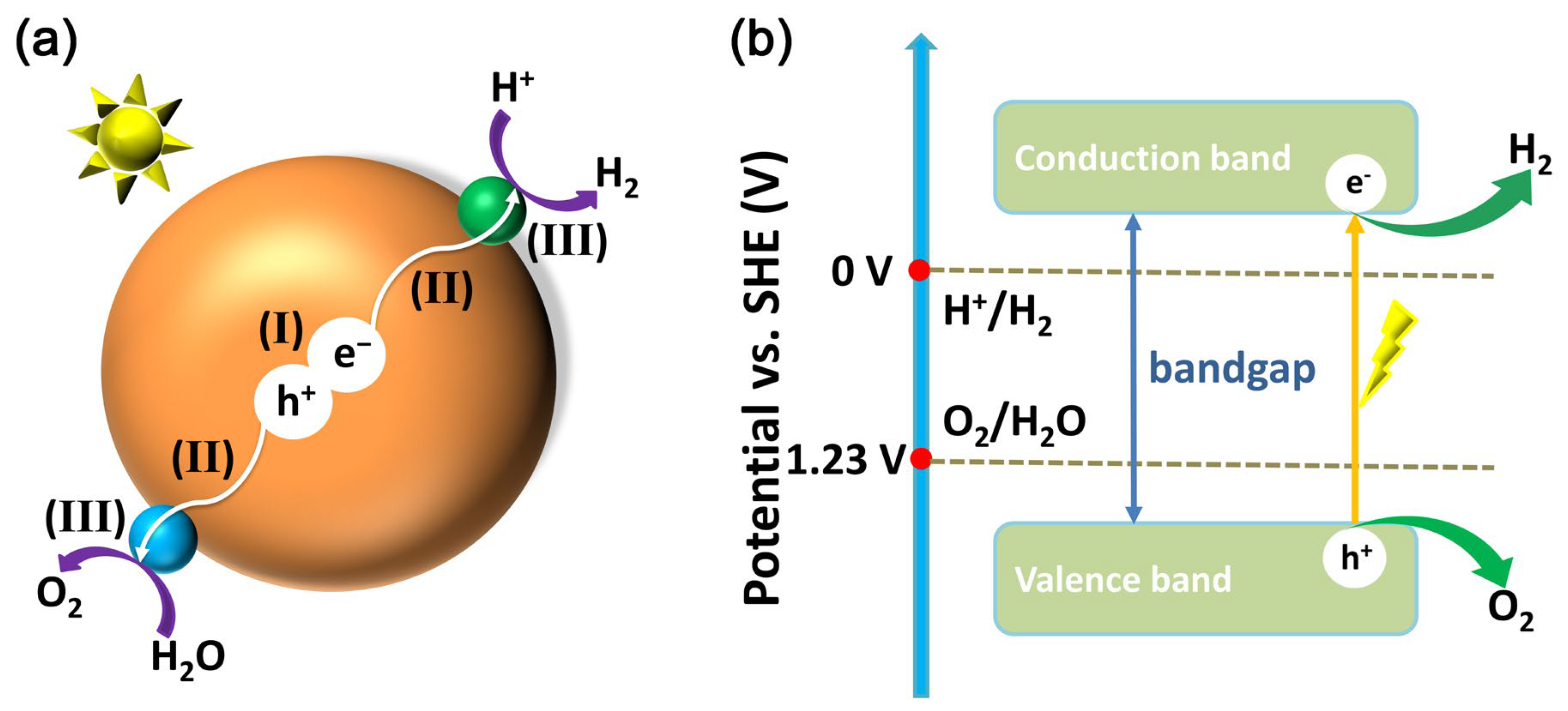

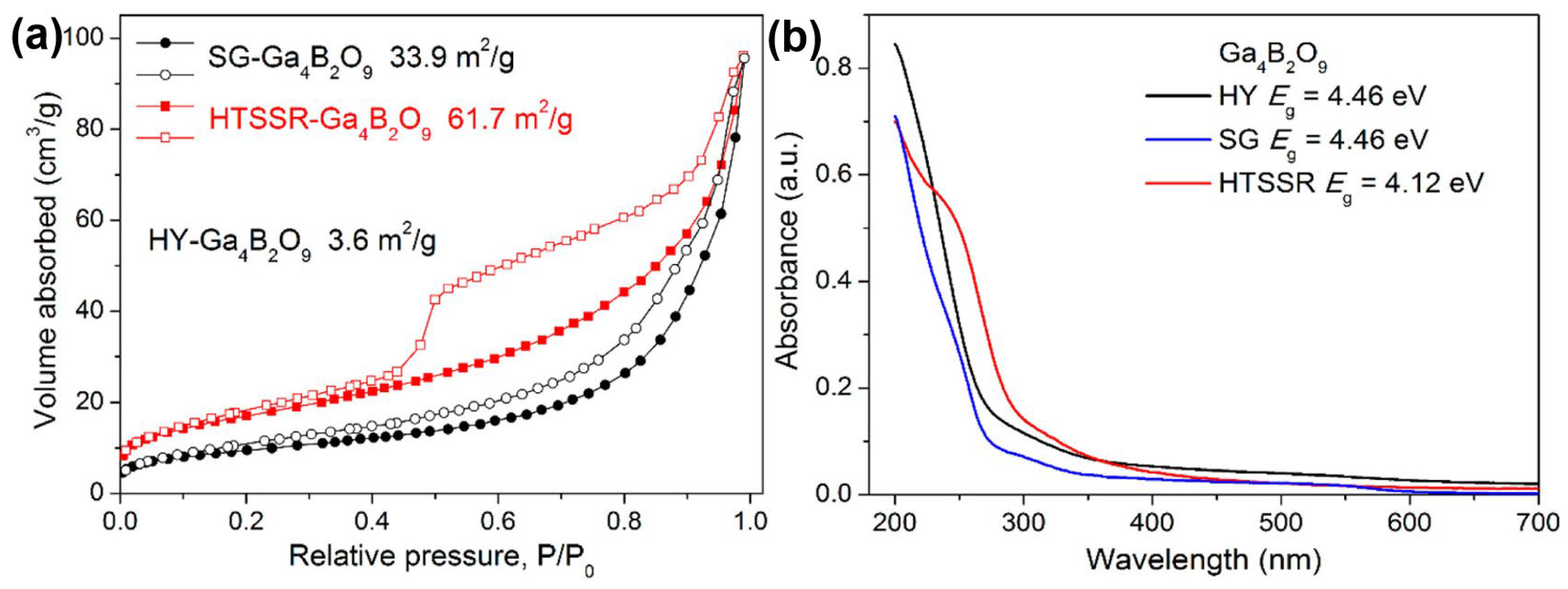



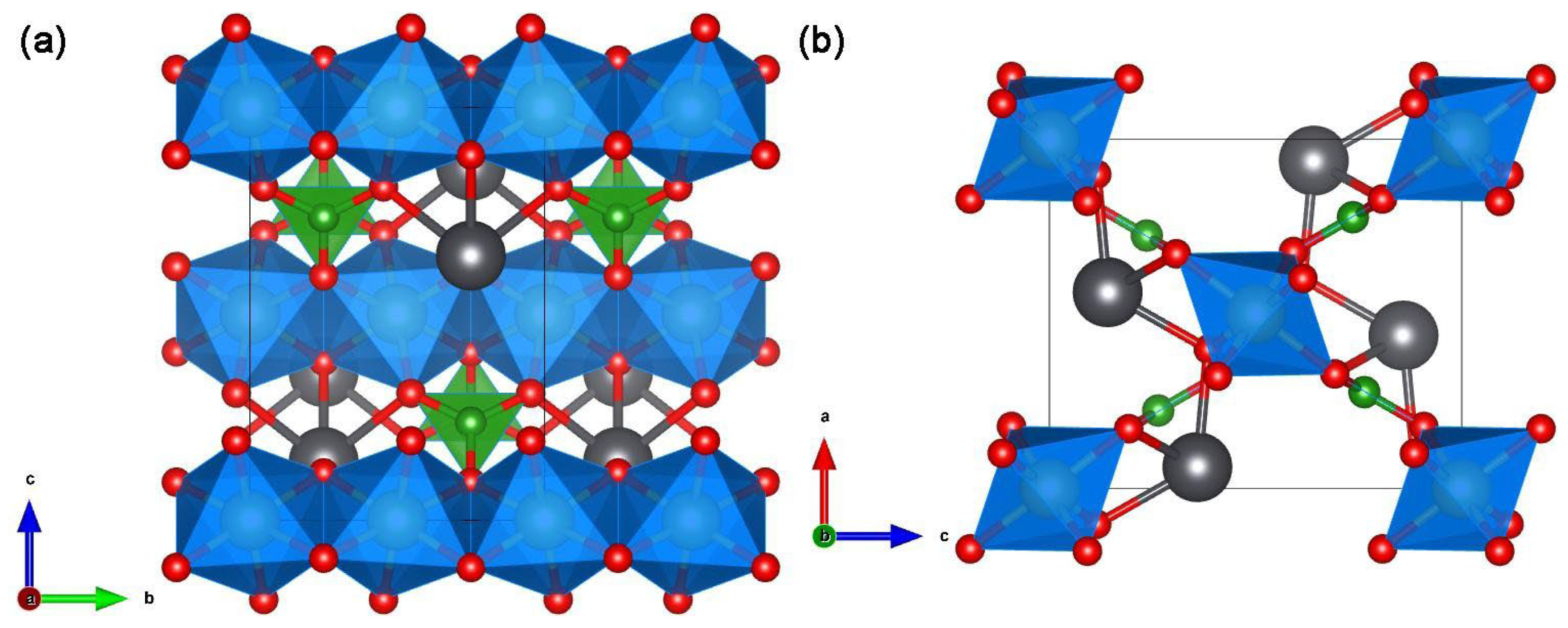
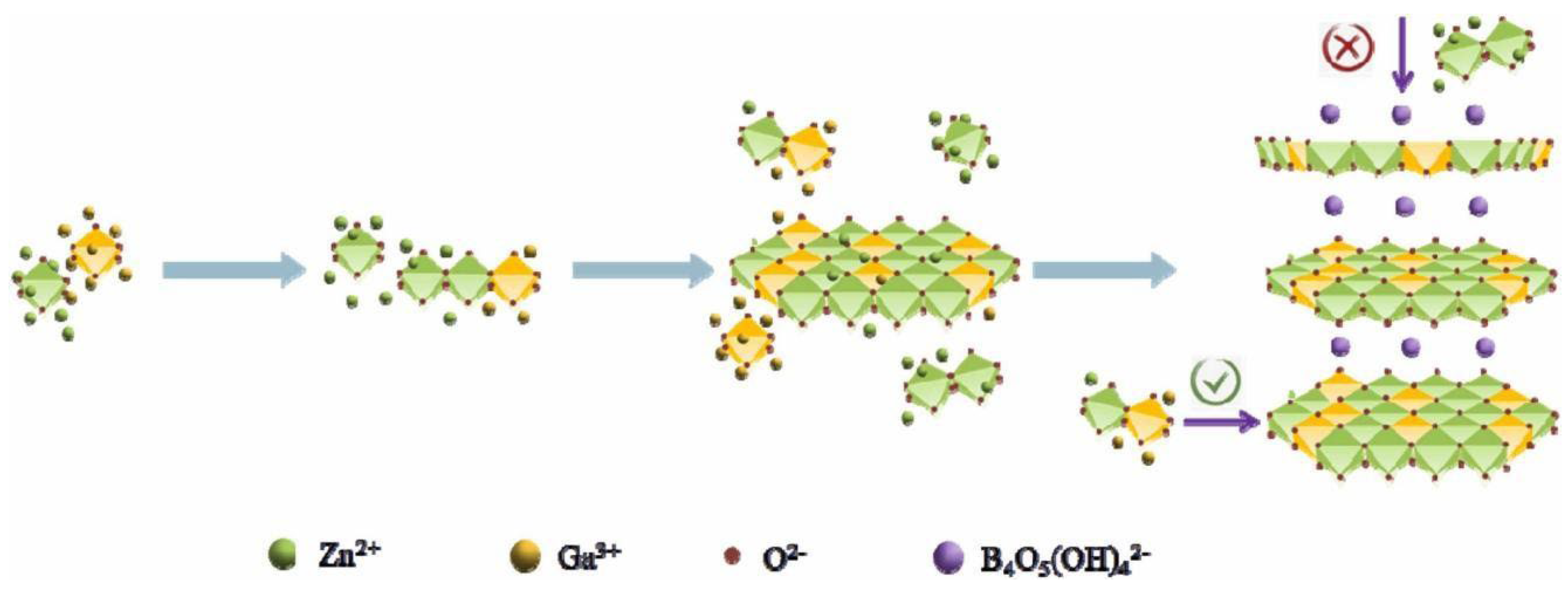
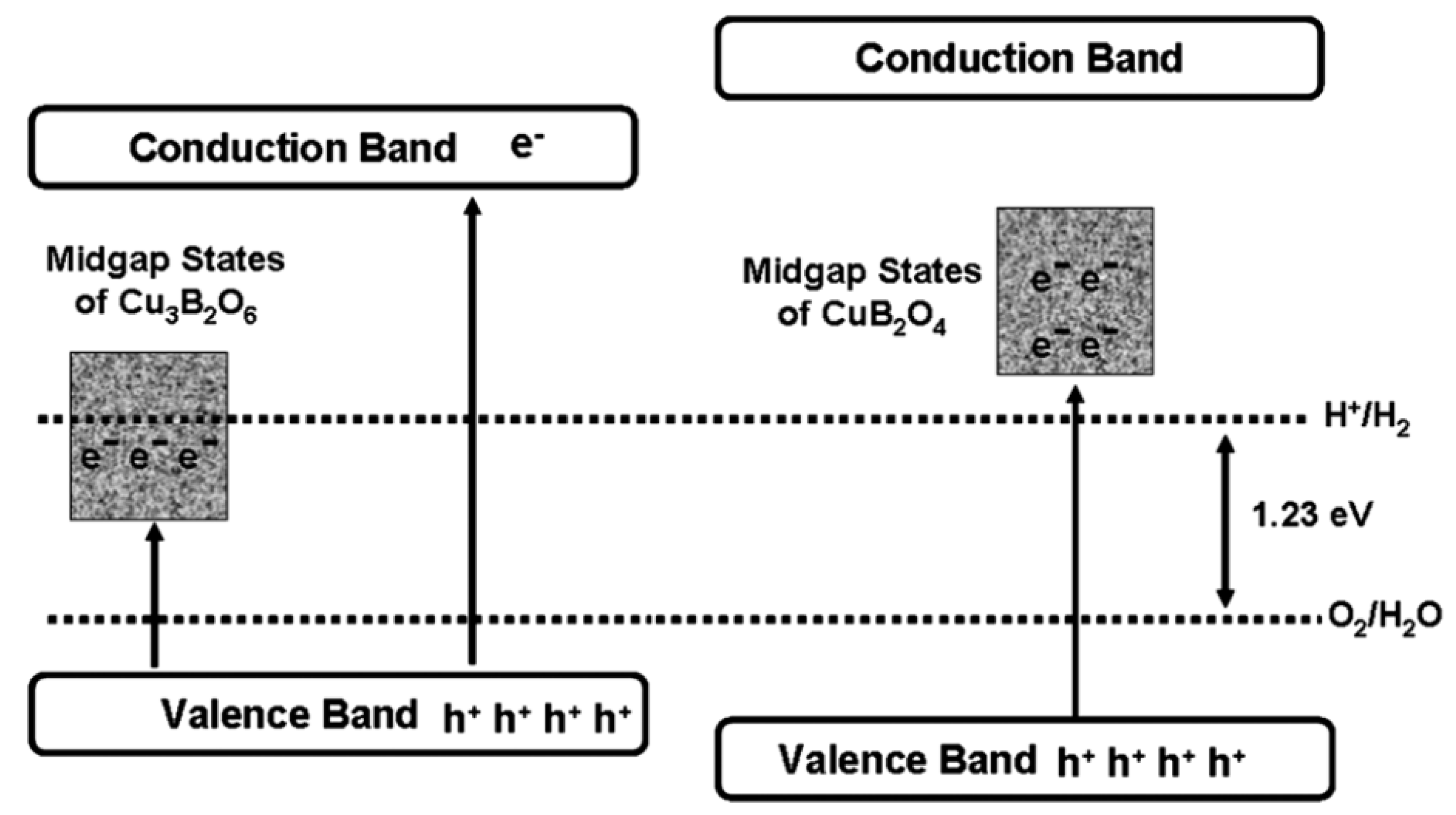

| Synthesis Method | Photocatalyst | Synthesis Condition | BET/m2g−1 | SEM/nm | Refs. |
|---|---|---|---|---|---|
| Solid-state | K3Ta3B2O12 | 1173 K, 10 h, excess 10% boron | 1 | 300~500 | [50,51] |
| 1173 K, 10 h, excess 20% boron | 1 | 500~800 | [50,51] | ||
| InBO3 | 1523 K, 72 h | 3 | 5000~10,000 | [52] | |
| Ga4B2O9 | 863 K, 10 h | 61.7 | - | [53] | |
| Cd12Ge17B8O58 | 1098 K, 15 h | - | ~7000 | [54] | |
| CuB2O4 | 1073 K, 12 h | negligible | 2000 | [55] | |
| Cu3B2O6 | 1173 K, 36 h | negligible | [55] | ||
| PbGaBO4 | 873 K, 5 h | - | micrometer | [56] | |
| NiaCo3−aB3O4 | 1223 K, 24 h | - | - | [49] | |
| Complex gelation | K3Ta3B2O12 | 1073 K, 5 h | 1.4 | ~200 | [57] |
| Ga4B2O9 | 893 K, 15 h | 33.9 | - | [53] | |
| Precipitation | InBO3 | 873 K, 2 h | 15 | 50~200 | [52] |
| 973 K, 2 h or 3 h | 14 | 50~200 | [52] | ||
| 1023 K, 2 h | 10 | 50~200 | [52] | ||
| 1073 K, 2 h | 5 | 50~200 | [52] | ||
| 1273 K, 2 h | 1 | 50~200 | [52] | ||
| Hydrothermal | Ga4B2O9 | 513 K, 120 h | 3.6 | - | [53] |
| ZnGa-BLDH | 353 K, 12 h | 100 | 5~6 | [60] | |
| Boric-acid flux | Ga-PKU-1 | 493 K, 120 h | 3.9 | - | [62] |
| InBO3 | 513 K, 120 h | 13.9~114 | 20~200 | [63] |
| Photocatalyst | Synthesis Method | Synthesis Condition | BG /eV | Light Source | Mass /mg | Cocatalyst | HER /μmol h−1g−1 | OER /μmol h−1g−1 | AQY (%) | Ref. |
|---|---|---|---|---|---|---|---|---|---|---|
| K3Ta3B2O12 | Solid-state | 1173 K, 10 h | 4.2 | 450 W-Hg-lamp | 1000 | - | 1790 | 860 | [50] | |
| K3Ta3B2O12 | Solid-state | 1073 K, 20 h | 4.2 | 450 W-Hg-lamp | 500 | - | 4780 | 2420 | 6.5@254nm | [50] |
| K3Ta3B2O12 | Complex gelation | 1073 K, 5 h | 4.1–4.2 | 450 W-Hg-lamp | 500 | - | 210 | 102 | - | [57] |
| K3Ta3B2O12 | Complex gelation | 1073 K, 5 h | 4.1–4.2 | 450 W-Hg-lamp | 500 | NiO | 784 | 384 | - | [57] |
| K3Ta3B2O12 | Solid-state | 1073 K, 5 h | 4.1 | 450 W-Hg-lamp | 300 | - | <50 | - | [58] | |
| K3Ta3B2O12 | Complex gelation | 1073 K, 5 h | 4.0 | 450 W-Hg-lamp | 300 | - | 633.3 | 333.3 | - | [58] |
| K3Ta3B2O12 | Complex gelation | 1073 K, 5 h | 4.0 | 450 W-Hg-lamp | 300 | NiO | 5333.3 | - | - | [58] |
| InBO3 | Calcite | 973 K, 3 h | 5.4 | 450 W-Hg-lamp | 500 | NiO | 796 | 404 | - | [52] |
| Ga4B2O9 | Solid-state | 863 K, 10 h | 4.12 | 500 W-Hg-lamp | 50 | - | 118 | 58 | - | [53] |
| Ga4B2O9 | Sol-gel | 893 K, 15 h | 4.46 | 500 W-Hg-lamp | 50 | - | 47 | 22 | - | [53] |
| Ga-PKU-1 | Boric-acid flux | 493 K, 120 h | 4.8 | 500 W-Hg-lamp | 50 | RuOx & Pt | 28.4 | 14.5 | - | [62] |
| Cd12Ge17B8O58 | Solid-state | 1098 K, 15 h | 4.27 | 500 W-Hg-lamp | 100 | NiOx | 163 | - | - | [54] |
| Photocatalyst | BG /eV | Light Source | Mass /mg | Sacrificial Agent | Cocatalyst | HER /μmol h−1g−1 | OER /μmol h−1g−1 | Ref. |
|---|---|---|---|---|---|---|---|---|
| CuB2O4 | 3.30 | >400 nm | 100 | Methanol or AgNO3 solution | - | 69.5 | 136.9 | [55] |
| Cu3B2O6 | 2.47 | >400 nm | 100 | Methanol or AgNO3 solution | - | 14.9 | 72 | [55] |
| Cu-Borate-1 | 2.3 | LED-450nm | 4 | TEOA solution | [Ir(ppy) 2 (dtbbpy)][PF6] | ~687.5 | - | [59] |
| Cu-Borate-2 | 2.3 | LED-450nm | 4 | TEOA solution | [Ir(ppy) 2 (dtbbpy)][PF6] | ~562.5 | - | [59] |
| Co3B2O6 | - | DC-Xe-lamp | 10 | Na2S2O8 solution | [Ru(bpy)3]Cl26H2O | - | 1822.3 | [49] |
| Co2NiB2O6 | - | DC-Xe-lamp | 10 | Na2S2O8 solution | [Ru(bpy)3]Cl26H2O | - | 1020.6 | [49] |
| CoNi2B2O6 | - | DC-Xe-lamp | 10 | Na2S2O8 solution | [Ru(bpy)3]Cl26H2O | - | 428.4 | [49] |
| Ni3B2O6 | DC-Xe-lamp | 10 | Na2S2O8 solution | [Ru(bpy)3]Cl26H2O | - | 373.2 | [49] | |
| InBO3 | 5.2 | 500 W-Hg-lamp | 500 | Methanol solution | - | 29.5 | - | [63] |
| InBO3 | 5.2 | 500 W-Hg-lamp | 500 | Methanol solution | NiOx | 56.1 | - | [63] |
| ZnGa-BLDH | 4.94 | 300 W-Xe-lamp | 10 | TEOA solution | 32 | [60] | ||
| Ga-PKU-1 | 4.8 | 500 W-Hg-lamp | 100 | Methanol or AgNO3 solution | Pt | 323 | 2030 | [61] |
| In19B34O74(OH)11 | - | 700 W-Hg-lamp | 1.82 | Pure methanol | - | 2.8 | - | [64] |
| In5B12O25(OH) | - | 700 W-Hg-lamp | 0.3 | Pure methanol | - | 220 | - | [66] |
| Ga2B3O7(OH) | 4.0 | 150 W-Hg-lamp | 0.18 | Pure methanol | - | 25.77 | - | [65] |
| Ga2B3O7(OH) | 4.0 | 150 W-Hg-lamp | 0.18 | Methanol solution | - | 9.83 | - | [65] |
Disclaimer/Publisher’s Note: The statements, opinions and data contained in all publications are solely those of the individual author(s) and contributor(s) and not of MDPI and/or the editor(s). MDPI and/or the editor(s) disclaim responsibility for any injury to people or property resulting from any ideas, methods, instructions or products referred to in the content. |
© 2024 by the authors. Licensee MDPI, Basel, Switzerland. This article is an open access article distributed under the terms and conditions of the Creative Commons Attribution (CC BY) license (https://creativecommons.org/licenses/by/4.0/).
Share and Cite
Sun, X.; Yang, J. A Mini Review on Borate Photocatalysts for Water Decomposition: Synthesis, Structure, and Further Challenges. Molecules 2024, 29, 1549. https://doi.org/10.3390/molecules29071549
Sun X, Yang J. A Mini Review on Borate Photocatalysts for Water Decomposition: Synthesis, Structure, and Further Challenges. Molecules. 2024; 29(7):1549. https://doi.org/10.3390/molecules29071549
Chicago/Turabian StyleSun, Xiaorui, and Jia Yang. 2024. "A Mini Review on Borate Photocatalysts for Water Decomposition: Synthesis, Structure, and Further Challenges" Molecules 29, no. 7: 1549. https://doi.org/10.3390/molecules29071549
APA StyleSun, X., & Yang, J. (2024). A Mini Review on Borate Photocatalysts for Water Decomposition: Synthesis, Structure, and Further Challenges. Molecules, 29(7), 1549. https://doi.org/10.3390/molecules29071549






